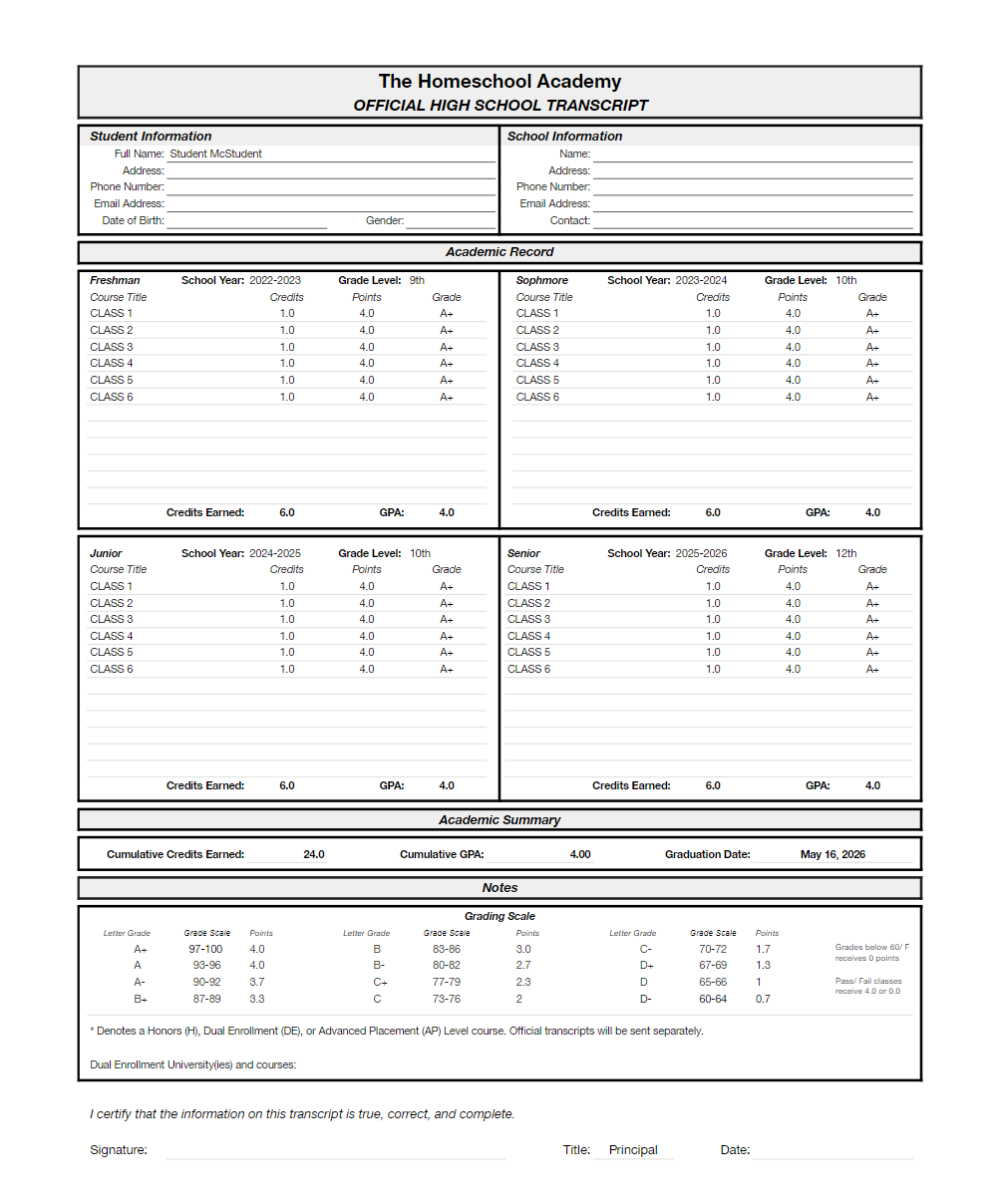Creating the perfect high school homeschool program starts now! As our young homeschoolers turn in to older homeschoolers their needs change drastically. Consequently, that means it is time for the parent-teacher to evolve too. Many homeschoolers have not even given a grade to an assignment up until now. That will need to change. Along with being the parent-teacher, you now get to be a guidance counselor and college admissions or career training consultant. (Don’t forget to update your resume.)
This shift can seem daunting. Fortunately, students tend to become much more independent at this stage, which will free up some of your time to help them discover what the next step is going to be. However, there is still a lot to keep on track – particularly if your child is college bound. We are going to make that simple.
Step 1: Know The Bare Minimum & Set Expectations
First, both you and your student need to know what must get done and the deadline. If your child is not college-track some of this will be less important, but having a transcript or educational resume is more than likely a bare minimum that all homeschool high school graduates will need.
Another consideration, as we head into the final stretch, is if you are considering enrolling in a structured school, college, or other program this is a great opportunity to make that educational shift. In fact, though states vary, it is extremely common for a district to deny your transcript and records – even those including dual enrollment classes from a junior college. All that to say, homeschooling high school should involve serious consideration because there will be serious commitment (and possibly consequences). Further, once you begin, consider it a four-year commitment.
Step 2: Sketch out a Four Year Plan
While we want our kids to be independent, as homeschooling parents you are the teacher, principal, and guidance counselor. You get to wear all the hats so do not feel any guilt at helping your kids get to where they aim to go. If they were enrolled in a government run school you can bet they would have help and resources available to them. Enjoy this time creating an individualized path. Here is a general timeline of things to do for a vocational school or college-bound student:
Four Year Homeschool High School Timeline
Freshman Year
SEMESTER ONE
- Discuss college plans
- Research admission requirements at colleges of interest (COI)
- Plot a course plan for the next four years (you can always adapt and change but it is good to see the pace you need) – determine if you want to pursue AP or CLEP testing
- Become involved in or continue extracurricular activities, clubs, and sports.
- Find somewhere you enjoy doing volunteer work
SEMESTER Two
- Research the financial commitment of your COIs
- Learn which tests (SAT, ACT, etc.) are preferred and scores needed to be competitive at your COIs
Summer
- Find a summer job, internship, or volunteer opportunity for the summer
- Read quality literature over the summer
- Begin visiting colleges
SOPHMORE Year
SEMESTER ONE
- Review your previous year’s college plans – narrow down the list
- Focus on specific programs your COIs offer
- Become involved in or continue extracurricular activities, clubs, and sports.
- Add at least 5 minutes of standardized test prep into the daily routine (ACT if you plan to take it in the spring)
- Find a place to take any anticipated AP or CLEP tests
SEMESTER Two
- After the ACT switch test prep to the PSAT
- Monitor financial costs at COIs
- Begin researching financial aid and scholarship options
- By April or May find a place to sign up for the PSAT that is administered in October
- If you complete an AP or CLEP-able course take the test in May
Summer
- Find a summer job, internship, or volunteer opportunity for the summer
- Continue reading quality literature
- Visit colleges
- Practice for the PSAT
- Begin networking with people in your major of interest to learn more about the day-to-day, actual workload, requirements, what helped them, and what did not.
JUNIOR Year
SEMESTER ONE
- Again, review your college goals and plans – make any necessary adjustments to your course of study. Your list of COI should included 20 or fewer schools. Get on their mailing lists – find any junior preview days.
- Should you decide a non-collegiate path: research your alternate options and narrow down a list of career interests, apprenticeships, military options, and/ or trade schools
- Become involved in or continue extracurricular activities, clubs, and sports.
- Continue to test prep. Take the PSAT in October. After begin prepping for the ACT.
- In December schedule your February ACT
SEMESTER Two
- Continue to test prep for the ACT
- February take the ACT. Switch test prep to SAT.
- By March find an AP and/ or CLEP location to test
- SAT option in March
- Build a resume
- Start applying for scholarships
- If you complete an AP or CLEP-able course take the test in May
- April ACT option; Register for May/ June SAT
Summer
- Find a summer job, internship, or volunteer opportunity for the summer
- Continue reading quality literature
- Request information from top COIs
- For athletes, register with the NCAA Initial Eligibility Clearinghouse
- Practice writing application essays
- Continue to prep for standardized tests, if you plan on taking them again
SENIOR Year
SEMESTER ONE
- Enjoy your final high school year! Spend time with family and friends.
- Review and adjust your plans and course of study (if necessary). Remember these are plans you can change them. Hopefully, you have focused on a solid foundation that can adapt to other pursuits.
- Compile a list of people you can ask for letters of recommendation. Get them requisite information early.
- Keep seeking out scholarships
- Stay involved in your activities and volunteer work
- Compile information needed and complete your FAFSA (save pay stubs) by the end of the year. Alternately, make understand the family’s financial plans for the college years
- November: Mail early decision applications
- December: Mail all other applications with all requisite addenda. If necessary, take the ACT and/ or SAT
SEMESTER Two
- Send thank you notes to any mentors, teachers, etc. who wrote you letters of recommendation for your applications
- Update your resume
- By March find an AP and/ or CLEP location to test
- Decide which school you will attend. Notify the other accepted colleges, in writing, of decision to decline their offers.
- If you complete an AP or CLEP-able course take the test in May
- Submit final requisite documents to choice college – housing, transcripts, financial aid, etc.
Summer
- Determine your finances for year one (apply for a job etc.)
- Have a great summer!
Four Year Timeline as Free Editable Google Sheet
When you subscribe below this Four Year Timeline, as free editable Google Sheet, is delivered directly to your inbox! Get it now.
Step 3: Organize a Transcript
Use your state’s specified guidelines for what is required for a homeschool educated child to graduate. Some states, like Texas, however do not have graduation requirements for homeschools. In this case many parents use the state’s minimum recommended high school program. For example, from the TEA guidelines, it suggest students should earn at least 22 credits: 4-English Language Arts credits, 3-Mathematics credits, 3-Science credits, 3-Social Studies, 2-Foreign Language credits, 1-Physical Education credit, 1-Fine Arts credit, and 5-Elective credits. Another track for homeschoolers is to opt to take a GED test.
If your child is likely college-bound it would behoove you to find out what the admissions requirements are of a few schools of interest and make those your minimum.
Though keeping grades and a transcript are not always a requirement, as you embark in the homeschool high school years you should. The benefit is, it gives your child more flexibility and options. Plus, if you keep one as you go along your life will be easier come senior year if, all of a sudden, they decide to go to college and need one. It will save you a lot of time and stress.
To help homeschoolers organize a transcript we have a fully customizable template for high school students. It autofills the courses and grades directly from the gradebook; as well as from the course description page. Also, two versions of the transcript are included – an unweighted and a weighted option. The grade scale is completely customizable. Further inclusions are a page for tracking extracurriculars and volunteer work as well as a page with transcript “best practices” and four gradebook options for classes with many assignments and/ or variously weighted grades.
Homeschool High School Transcript Template
Step 4: Choose and Take Classes
Now it is time to get specific. Because you are homeschooling you and your student have the flexibility to craft an engaging and exciting course load. Do not be limited by British Literature or General Science. Explore deeply, find the classes that best put your child on track to achieve their goals. A future writer might load up on writing as a craft over traditional composition. Or, just because the literature is British does not mean it all has to be from the Victoria Era. Feel free to hone in on various themes like Dystopian Literature or Military Leadership. A kid who wants to be a marine biologist does not need to take simple science, fill it out with classes like anatomy, zoology, marine biology, etc.
Consider if your student is interested in taking Dual Enrollment courses or the PSAT. These are possible for homeschoolers but take a few extra steps, so give yourself plenty of time to organize them.
Step 5: Enjoy the Ride
Remember back to the days of yore…for some of us that is the old 1900’s. High School is an exciting time for students, but you have been there every step of the way. So much of the high school years is seeing the “pay off” of all the hours you spent teaching and worrying and loving them so darn much. Be sure to enjoy it and them as much as possible. You have honed a great person who is almost ready to go out into the world!




